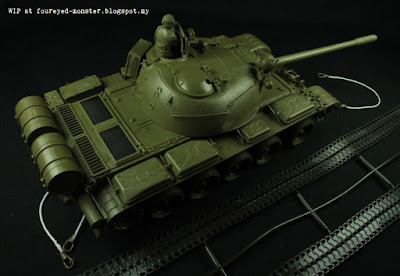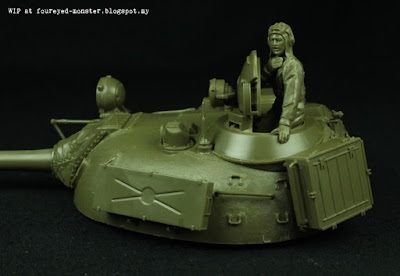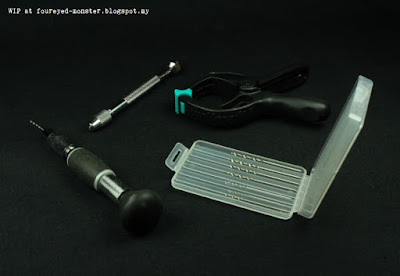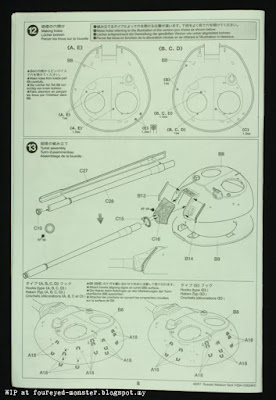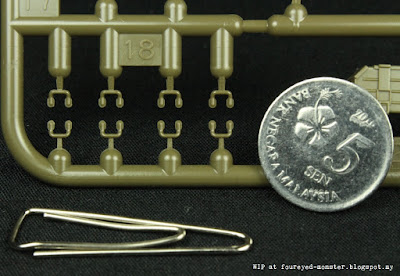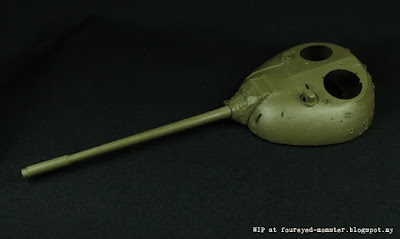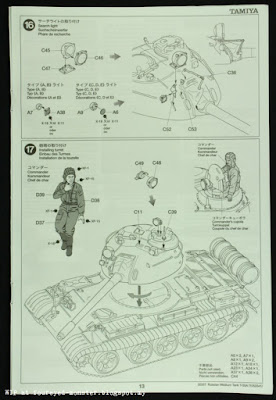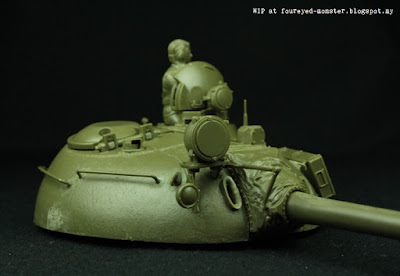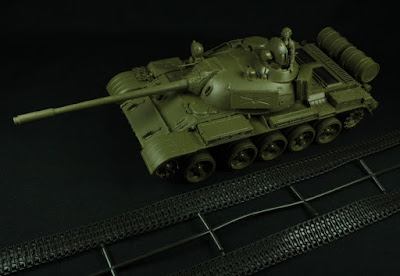Prior to the first dry fitting using parts already painted, there was one further section of the snowspeeder to complete namely its power generator with cooling fins. But before I began work, something kept tugging at the edge of my mind and wouldn't let go. Then
it hit me. Why were the snowspeeder's cooling fins painted in hues usually associated with insulating material? It didn't make sense to use insulators to cool the power generators. Although the
Star Wars universe is all make-believe, the functioning of its vehicles should - at the very least - make rudimentary sense.
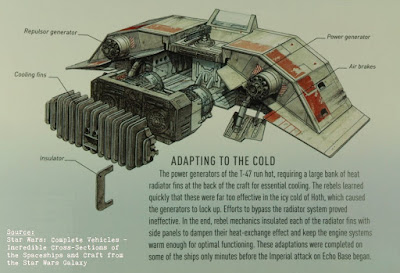 |
| Snowspeeder's technical data was used as a basis for color scheme selection of the cooling fins |
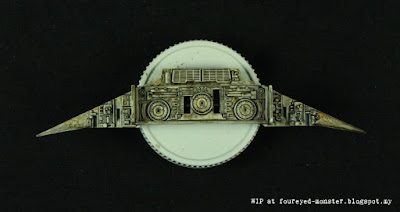 |
| Colour scheme for the power generator was also inspired by DK's Star Wars Complete Vehicles |
 |
| Snowspeeder cooling fins are more or less complete; a mixture of metallic and insulating material colours |
One of my biggest faults in this scale model hobby is the tendency to fuss over the smallest details to ensure everything is close to perfect. And this silly little conundrum was threatening to put a spanner in the works. So some research was in order. Luckily for me I found the answer quickly in a
DK reference book titled
Star Wars: Complete Vehicles. (If you are interested, the answer is in the very first photo.) In a two-for-one deal, the book also conveniently provided me with a colour scheme I liked and eventually used
versus the mostly black-to-black grey versions adopted by other modellers.
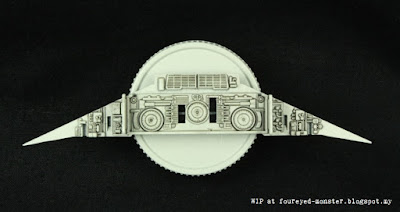 |
| Power generator was given the same treatment as the hull i.e. black grey panel lining over an off-white basecoat |
My starting off point was a power generator painted in a
similar scheme (sans orange stripes) to the upper and lower hulls. This entailed using the
Tamiya AS-20 Insignia White (US Navy) as the primary hue followed by a clear coat of
Tamiya TS-13 which in turn served as a protective layer against a black grey
Tamiya Panel Line Accent Color mixture (see immediate photo above). Following this, it was the turn of the enamel-based weathering paints/washes of which I used a combination of AK Interactive stuff like
AK082 Engine Grime,
AK025 Fuel Stains and
AK046 Light Rust.
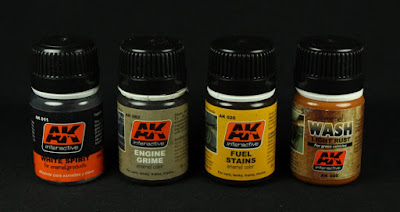 |
| AK Interactive enamel-based weathering washes, paints and solvent |
 |
| Weathering products are sometimes used not as intended but purely for their colours |
A fairly copius amount of
Engine Grime was applied to the power generator followed subsequently by a lesser amount of
Fuel Stains and lastly a selected placement of
Light Rust. I chose these enamel paints/washes primarily for their hues which ranged from a Van Dyke brown-like shade to a Sienna brown hues and ending with a brownish orange highlight. So as you might've guessed by now I didn't use the enamel paints as they were intended for. I don't think the
Rebel Alliance engineers - as poorly equipped as they were relative to the
Imperial Navy - would've allowed the power generator to be coated with either fuel or rust. Even when taking into account Hoth's harsh winter climate.
 |
| Step 1: Apply AK Interactive Engine Grime |
 |
| Layer of engine grime was fairly light in view of the subsequent weathering it was to receive |
In the wake of time constraints, I hadn't allowed the enamel paints sufficient time to dry before the subsequent layer was applied. This I did even though I knew the earlier layer will likely be washed off by the solvent inherent in the subsequent enamel paint. For some reason I thought I could manage. Well long story short, to compensate for the rush-job I mixed half-tones of the enamel colours and applied it randomly as well as reapplied enamel colours that were cleaned off where appropriate.
 |
| Step 2: Apply AK Interactive Fuel Stains |
 |
| Sienna-like browns of fuel stain complement the van-dyke browns of the engine grime |
Truth be told I'm tempted to darken the entire colour scheme with a dark brown wash. But I'm holding off on the expectation that everything will look darker anyway - by being partially hidden in shadows - once the cooling fins are attached onto the power generator.
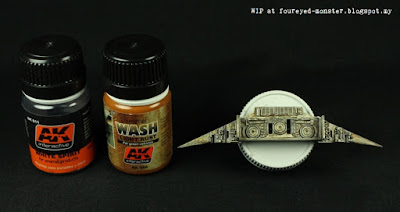 |
| Step 4: Apply AK Interactive Light Rust Wash |
 |
| Of all three enamel-based paints, the Light Rust Wash was used the least |
Speaking of the cooling fins, I first painted it in
Tamiya TS-82 Rubber Black which incidentally is an excellent hue to mimic insulating material. Then
Tamiya XF-16 Flat Aluminum was dry brushed onto the edges of the fins to depict the insulators wearing off to reveal the fin's metallic nature underneath.
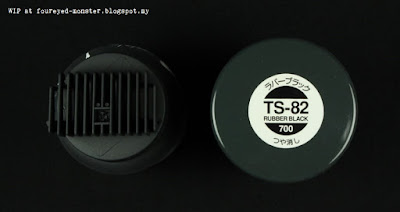 |
| Tamiya TS-82 Rubber Black was just the right hue for an insulating material |
 |
| Tamiya XF-16 Flat Aluminum was dry brushed onto the cooling fins as the finishing touch |
Meanwhile, I couldn't resist painting yet another unlikely-to-be-seen again part. This time it was the interior of the canopy roof. And because it will be largely hidden from view once assembled, I only did the bare essentials. Enough for a colour scheme (similar to the cockpit interior) to show through even if you caught just a glimpse of it. A case for the KISS principle ... keep-it-simple-stupid.
 |
| Roof interior of the snowspeeder canopy, which will largely be hidden from view once assembled |
Okay, so it's all set now for an 'initial put together' or a dry-fitting of sorts to see how existing painted parts look when assembled. It's also the first chance for me to see if the colour scheme of the pilots combine well with that of the cockpit interior. After that, things should start moving quickly as I already know how I want to paint the snowspeeder's repulsor/laser/power system, air brakes, etc. That's the next step in this
Star Wars 1/48 scale build. Until then, thanks for following my progress on this project and have yourself a great weekend ahead.





























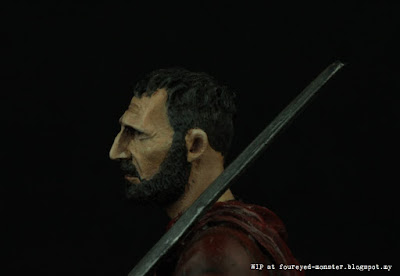


.jpg)

